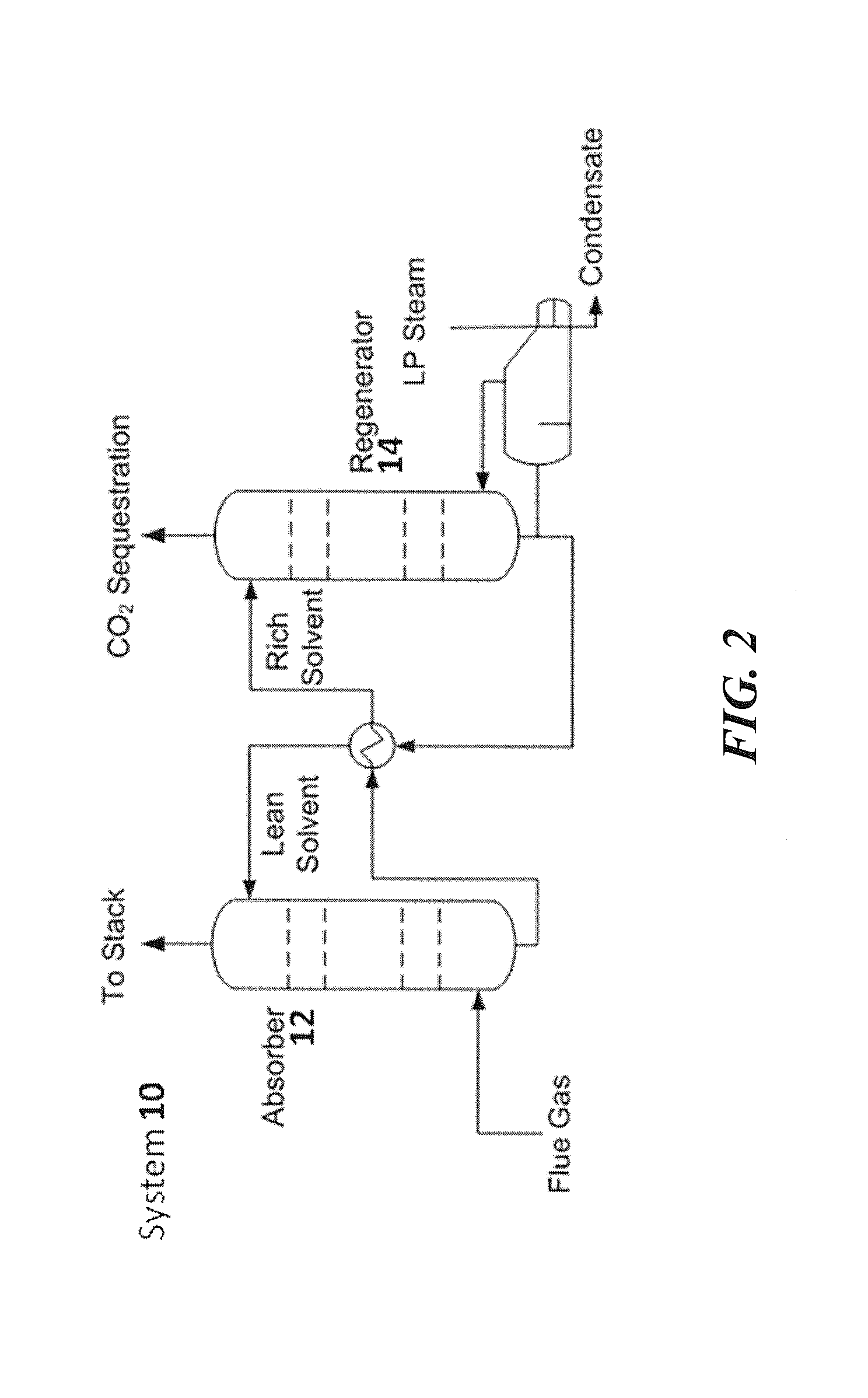Regenerable solvent mixtures for acid-gas separation
a solvent mixture and acid-gas technology, applied in the field of solvent systems, can solve the problems of contributing to the cost of purified products, the cost of purified acid-gas has become a significant hurdle, and the performance of flue gas is not good in the humid, near-ambient pressure conditions
- Summary
- Abstract
- Description
- Claims
- Application Information
AI Technical Summary
Benefits of technology
Problems solved by technology
Method used
Image
Examples
example 1
Absorption of CO2 by 1,1,3,3-tetramethylguanidine / 2,2,2-trifluoroethanol resulting in formation of a carbonate ester.
[0056]An equimolar solution of 1,1,3,3-tetramethylguanidine (“TMG”) and 2,2,2-trifluoroethanol (“TFE”) was prepared, resulting in an exothermic event with moderate generation of heat. The solution was placed in an impinger and purged with a binary gas mixture containing approximately 13% CO2 (balance nitrogen). The CO2 concentration of the gas exiting the reactor was monitored by an NDIR CO2 analyzer. The CO2 loading curve is shown in FIG. 7. Upon heating the solution to 80° C. in a flowing stream of nitrogen, the absorption was reversed, resulting in the release of approximately 0.56 moles CO2 / mole amine.
[0057]FIG. 8 provides a nuclear magnetic resonance (NMR) spectrum of the result of the reaction between the TMG / TFE solvent system and gaseous CO2. In an NMR tube at room temperature, 1,1,3,3-tetramethylguanidine (0.6 mmol) was combined with 2,2,2-trifluoroethanol (0...
example 2
Absorption of CO2 by an ionic liquid consisting of an equimolar mixture of 1,1,3,3-tetramethylguanidine and 1,1,3,3-tetrafluoropropanol
[0060]1,1,3,3-tetramethylguanidine was combined with an equimolar amount of 2,2,3,3-tetrafluoropropanol, giving an exothermic reaction occurs resulting in formation of a room temperature ionic liquid, with initial conductivity equal to approximately 440 μS / cm2, as shown in FIG. 9. This figure further shows that, when the ionic liquid was purged with a binary gas mixture composed of approximately 13.3% CO2 (balance nitrogen), the conductivity of the solution increased to a maximum of approximately 1175 μS / cm2. This data (an increase in conductivity) corresponds to the absorption of CO2 by the solution as evidenced by the observed decrease in the concentration of the gas passing through the solution as followed with a CO2 analyzer utilizing NDIR spectroscopy. The solution absorbed approximately 0.35 moles CO2 / mole of amine. When heated to approximately...
example 3
Absorption of CO2 by an ionic liquid consisting of an equimolar mixture of 1,1,3,3-tetramethylguanidine and 2,2,3,3,4,4,-hexafluorobutanol
[0061]An equimolar mixture of 1,1,3,3-tetramethylguanidine with 2,2,3,3,4,4-hexafluorobutanol formed a room temperature ionic liquid is formed, with initial conductivity equal to approximately 400 μS / cm2 as shown in FIG. 10. As further shown in this figure, when the ionic liquid was purged with a binary gas mixture composed approximately 13.3% CO2 (balance nitrogen) the conductivity of the solution increased to a maximum of approximately 800 μS / cm−1. This data (an increase in conductivity) shows that the solution absorbs CO2 as evidenced by the observed decrease in the concentration of the gas passing through the solution as followed with a CO2 analyzer utilizing NDIR spectroscopy. This indicates that the lean solvent is an ionic liquid whose conductivity increases with absorption of carbon dioxide. The solution absorbed a total of approximately 0...
PUM
| Property | Measurement | Unit |
|---|---|---|
| pKa | aaaaa | aaaaa |
| molar ratio | aaaaa | aaaaa |
| molar ratio | aaaaa | aaaaa |
Abstract
Description
Claims
Application Information
 Login to View More
Login to View More - R&D
- Intellectual Property
- Life Sciences
- Materials
- Tech Scout
- Unparalleled Data Quality
- Higher Quality Content
- 60% Fewer Hallucinations
Browse by: Latest US Patents, China's latest patents, Technical Efficacy Thesaurus, Application Domain, Technology Topic, Popular Technical Reports.
© 2025 PatSnap. All rights reserved.Legal|Privacy policy|Modern Slavery Act Transparency Statement|Sitemap|About US| Contact US: help@patsnap.com



